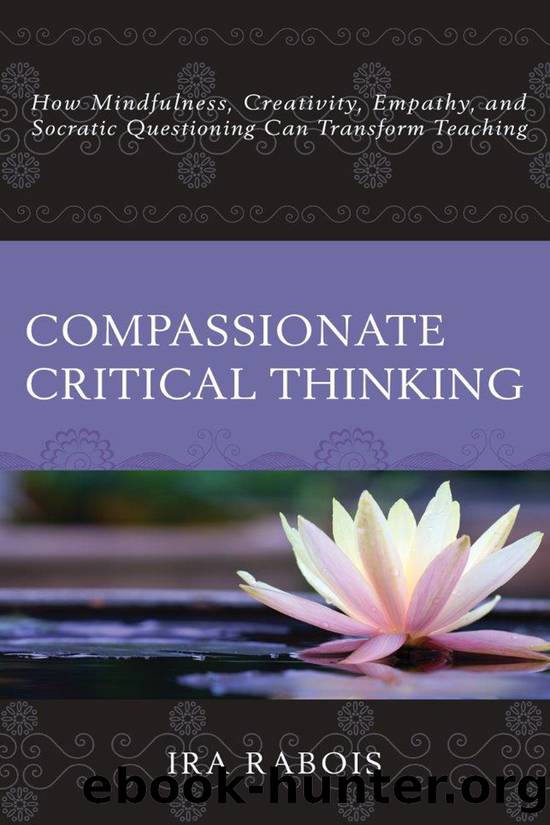Compassionate Critical Thinking by Rabois Ira;

Author:Rabois, Ira;
Language: eng
Format: epub
Publisher: Rowman & Littlefield Publishers, Incorporated
To end the class, discuss diagraming the components of anger. (See table 3.2) âWhen youâre home, in order to pull together all that youâve learned about anger, make a chart of its components. Write down what triggers anger. In the first column, record the physiology of angerâwhat goes on inside you, what sensations do you feel, where do they arise in your body, and what physiological changes lead to those sensations? What does anger âfeel likeâ to you? In the second column, record the thoughts and stories that go on in your mind and the psychological explanations for those thoughts. In the third, record, what are the evolutionary uses for anger, what actions you imagine taking. And record interventions that you think will work with you.â
âTake time to contemplate anger and what often results from it. Explore your own experiences. Are there stories that come up whenever you get angry? Can you find any patterns to your feelings? Treat your stories like clues to the mystery of yourself. The book of yourself is a great book. Learn from it. Enjoy it.â
As a teacher, you need to remember to consult or recommend students speak with support staff, especially if students show persistent alienation, anger, anxiety, depression, and similar emotions.
Lesson Sixteen: Joy and Fear
Readings to Give Background for Discussion
⢠Paul Ekman, Emotions Revealed, 152â171.
⢠Daniel Goleman, Emotional Intelligence, 297â300.
When fear arises in a class, due to a test, one studentâs response to another studentâs actions, or a news event, make the conscious intent to face the fear sensitively and directly, with as much skill and compassion as you can bring to it. Obviously, fear can be a difficult subject to study in school. You have to be careful about bringing up deeply troubling memories. One way to start the discussion is first exploring joy. After greeting the students, ask them to be seated and begin mindfulness practice.
The Practice
âLet your mind and body settle down. Take a breath in, and then out. Just be easy on yourself. With your next breath, let your eyes close partially or fully. Relax into the breath and let your awareness follow it.â
Pause to let students follow the breath on their own for a few seconds.
âWhat does the word âjoyâ bring up for you? What images come to mind, or feelings? Allow the memory or idea of a joyous moment to come to mind. Or allow joyous words to come to you. What were you doing when you felt joyous? What did it feel like? Breathe in and feel what it is like to breathe joy. You can even say to yourself: âI breathe in joy.â Breathe out and say to yourself: âI breathe out in joy.â Just breathe in and feel the moment of joy arise inside you. And breathe out in joy. Is joy energetic or lethargic? Is it light and open, or heavy? Notice how, when you feel joy, the world feels just right as it is. Just breathe it in and breathe it out. Sit for a moment with the feeling or idea of joy.
Download
This site does not store any files on its server. We only index and link to content provided by other sites. Please contact the content providers to delete copyright contents if any and email us, we'll remove relevant links or contents immediately.
Macmillan Primary Grammar 2 Pupil's Book by Unknown(379)
Figuring Out Fluency in Mathematics Teaching and Learning, Grades K-8 by Jennifer M. Bay-Williams & John J. SanGiovanni(344)
The Principal's Guide to Curriculum Leadership by Sorenson Richard D.;Goldsmith Lloyd M.;Mendez Zulma Y.;Maxwell Karen T.;(266)
English Grammar Practice--The Noun by Roxana Nastase(228)
Learning from Accidents 3rd ed by Trevor Kletz (2001)(226)
Harnessing Technology for Deeper Learning by Scott McLeod(215)
Text-Dependent Questions, Grades K-5 by Douglas Fisher & Nancy Frey & Heather Anderson & Marisol Thayre(211)
A Guide to Curriculum Mapping by Hale Janet A.;(202)
English Language Program Administration by Unknown(199)
Deep Change Leadership by Reeves Douglas;(190)
How to Do Everything with Google Tools by Unknown(188)
The Grammar Teacher's Activity-a-Day by Jack Umstatter(179)
The Power of SMART Goals by Conzemius Anne;O'Neill Jan; & Anne Conzemius(177)
Beyond the RTI Pyramid by Bender William N.;(158)
Aligning and Balancing the Standards-Based Curriculum by Squires David A.;(156)
Using Data to Close the Achievement Gap by Johnson Ruth S.;(156)
Using Equity Audits to Create Equitable and Excellent Schools by Skrla Linda E.;McKenzie Kathryn B.;Scheurich James Joseph;(151)
Differentiated Instructional Strategies for the Block Schedule by Gregory Gayle H.;Herndon Lynne E.; & Lynne E. Herndon(145)
You've Got to Reach Them to Teach Them by Schreck Mary Kim; & Schreck(140)
